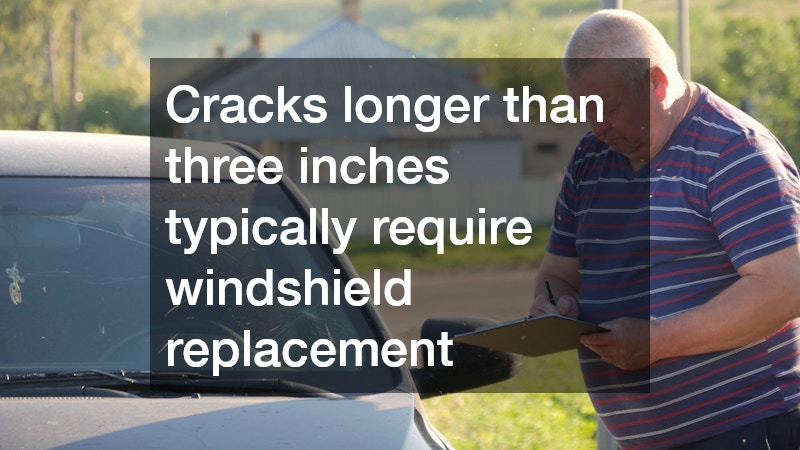This article explores the critical decisions vehicle owners face when dealing with windshield damage. We’ll discuss key considerations to determine whether windshield repair or replacement is the best choice for your vehicle.
What are the main factors to consider when deciding between repair and replacement?
The decision between windshield repair and replacement primarily hinges on several key factors. First, vehicle owners must assess the size and type of damage present.
Generally, smaller chips can often be repaired, while larger cracks may necessitate a full replacement. Secondly, the location of the damage plays an essential role in this determination. Damage right in the driver’s line of sight may impair visibility, necessitating a replacement for safety reasons. Lastly, cost considerations are vital; repair is typically less expensive than replacement, but the extent of the damage must justify this option.
Moreover, the age and condition of the windshield can influence the decision. Older windshields may be more prone to further damage or may not be worth the cost of repair. On the flip side, newer windshields, with fewer imperfections, may only need minor repair work. Understanding the warranty for both repair services and replacements is also crucial; some insurance policies cover repairs entirely, while replacements may carry deductibles. Overall, evaluating these factors ensures that vehicle owners make a well-informed choice that balances safety with financial considerations.
Finally, it’s essential to consider the long-term implications of the decision. A quick windshield repair can restore functionality, but it might not address underlying issues, leading to more extensive damage down the line. On the other hand, if a windshield needs to be replaced, it ensures a clear view and greater vehicle safety moving forward. To make an informed choice, it’s often beneficial to consult with a professional who can provide insights tailored to the specific situation surrounding each individual vehicle.
How does the type of damage affect the decision-making process?
When considering the type of damage, various factors come into play that can significantly alter the repair or replacement decision. Chips can often be repaired if they’re smaller than a quarter and not located near the edges of the windshield. However, if a chip shows signs of spreading or deep penetration, a full replacement may be necessary to maintain safety and structural integrity. Cracks longer than three inches typically require windshield replacement due to a higher likelihood that they will compromise the glass’s strength.
Spiderweb cracks present a unique situation as they can indicate more significant damage. These cracks radiate outward, potentially obstructing vision and necessitating a full windshield replacement for safety reasons. The location of such fractures also matters, as cracks that interfere with the driver’s view are more critical and usually require swift action. Before deciding, understanding the progression of different types of damage can shape how vehicle owners approach repairs versus replacements.
Outside factors, such as weather conditions and potential driving hazards, can also impact which options may be viable. A failing windshield in harsh weather conditions, such as heavy rain or snow, presents serious safety hazards that might pressure car owners to opt for replacement rather than waiting for a repair. Therefore, understanding the intricacies of each type of damage is crucial in guiding the decision-making process toward either windshield repair or replacement.
What are the potential risks of delaying repair or replacement?
Delaying a windshield repair or replacement carries several significant risks. Primarily, a damaged windshield can severely impair visibility, which is crucial for safe driving. Any obstruction can cause accidents, putting the driver’s life, as well as the lives of passengers and other road users, at risk. Failing to address windshield damage promptly increases the chances of encountering even more severe obstacles while driving, making it pivotal to act quickly.
There’s a real possibility of the damage worsening over time, especially with changing weather conditions. For instance, temperature fluctuations may cause cracks to expand or chips to deepen, turning a simple repair into an urgent replacement scenario. The longer one waits to make a decision, the more costly the repairs can become. Regular maintenance and timely responsiveness to windshield damage can save both time and money in the long run.
Lastly, unresolved windshield damage can have implications for insurance coverage. If the damage worsens and a driver seeks to file a claim for a full windshield replacement, the insurance company might compare the current scenario to what it would have cost to fix the initial issue. In some cases, if the damage is deemed to have resulted from negligence, the claim could be denied, resulting in higher out-of-pocket expenses. Therefore, addressing windshield damage without delay is a critical consideration for all vehicle owners.
To make an informed decision regarding windshield repair or replacement, consider the factors mentioned in the article. Always prioritize safety and consult with professionals to ensure the best outcome for your vehicle.



